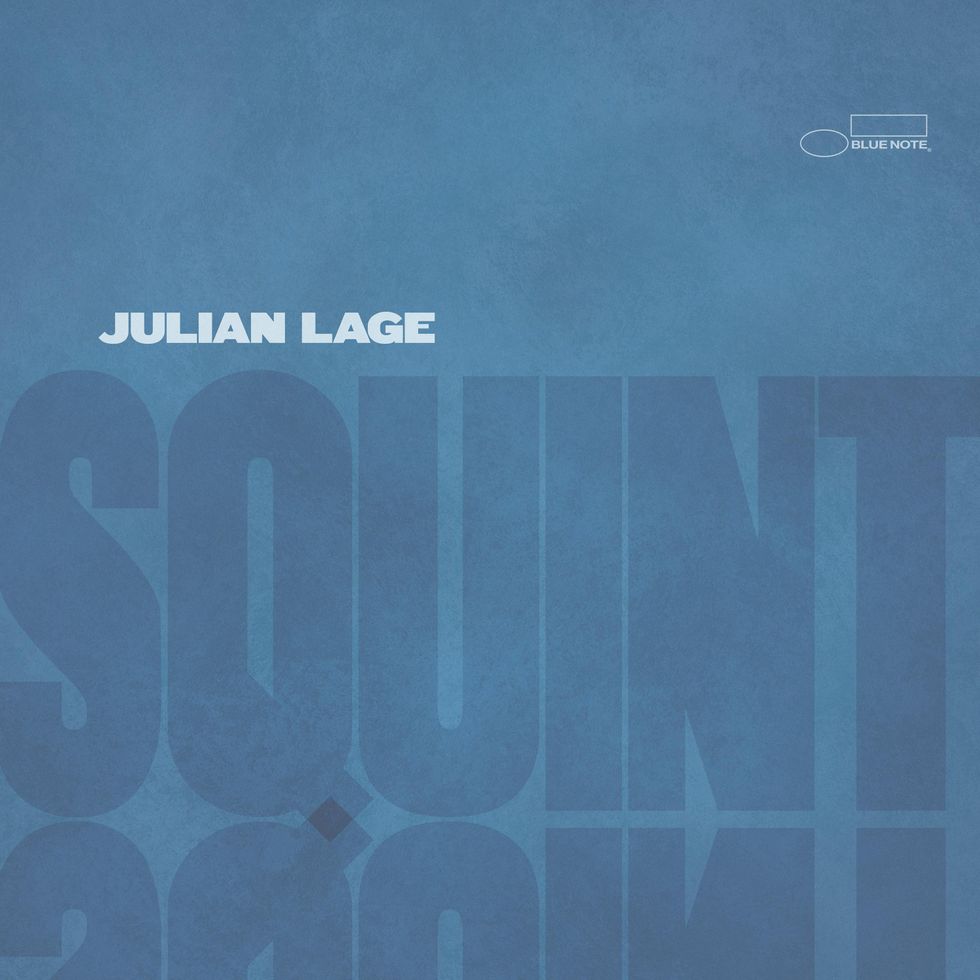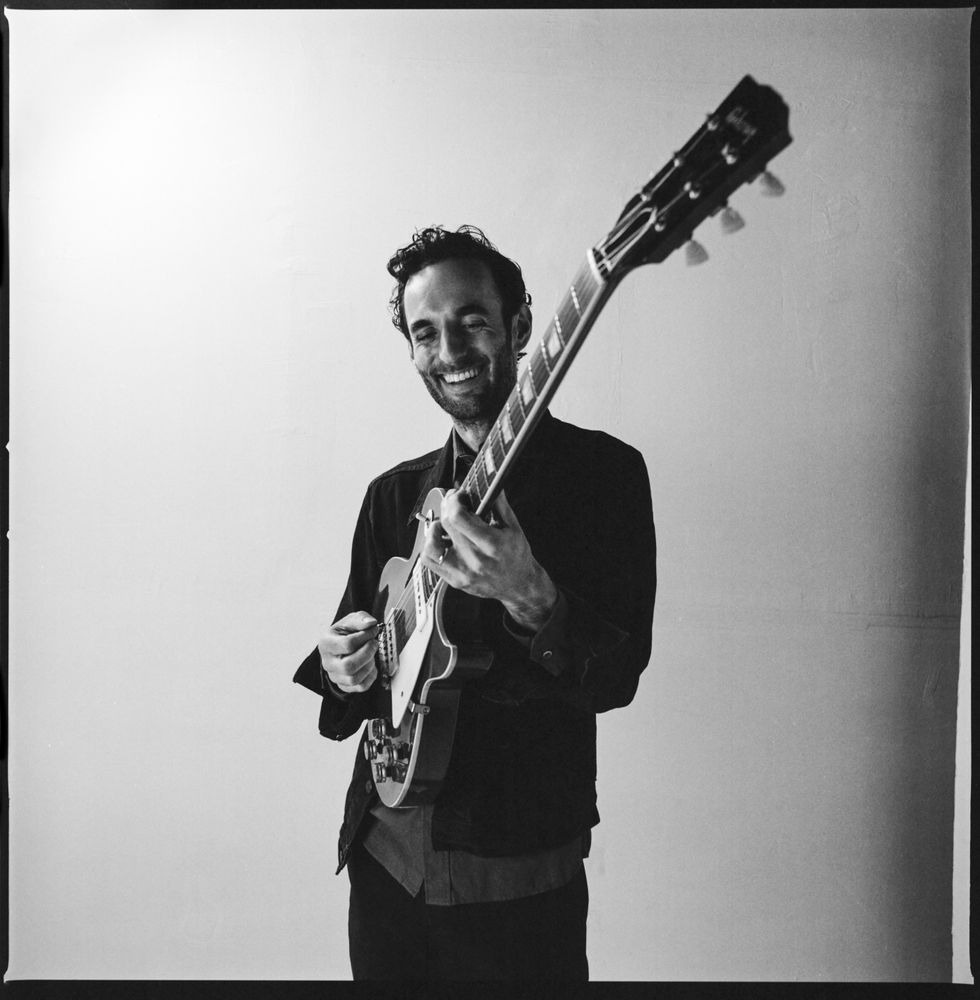Getting signed to Blue Note Records—the onetime home of John Coltrane, Lee Morgan, Miles Davis, Kenny Burrell, and many, many other greats—is a high honor in the jazz world. "It's just incredible," says Julian Lage, whose new album, Squint, is his debut for the famed label. "It's thrilling and inspiring and absolutely makes me want to be a better musician." But sometimes, simply being a better musician in a technical sense isn't enough. In the period between when the COVID lockdown began and the start of Squint's sessions with his trio in August, Lage had an epiphany during the "months of playing these songs, hours on end by myself. I wanted to write songs that would be restorative to play.
"Way beyond the shutdown was a global reckoning of racial injustice, systemic racism, social injustice, gender inequality, and all of these things that are ever-present, but now, here, on a very large scale, there's a discussion," he observes.
So Lage determined to craft an album that could be transformative for both himself and his listeners. "Is this positive music that's pretty for the sake of being pretty," he asked himself, "or is it music that holds a space for a little more fuzziness or emotional complexity? And in addition to just shutting up and listening and learning and saying, 'Wow, this is the work of our lifetime,' I think in not making the record [when we expected to], I developed a real appreciation for the role of sound in music and art with regard to healing. It's a method of transmission, and 'What are you transmitting?' became the question … You make music because you need to make it, you play it because you need to play it," he says. "Then it's by the grace of much higher powers that it ever sees the light of day. Squint is about the unknown, but is also celebrating deep gratitude."
Julian Lage - Saint Rose (Visualizer)
The 33-year-old virtuoso's perspective isn't a surprise to anyone who's met him. Lage has earned a reputation for being genuine and humble, and exuding gratitude is part of his way of experiencing life. He lives up to the Zen adage: The way you do one thing is the way you do everything.
But let's rewind to early 2020: Lage and his trio, which includes bassist Jorge Roeder and drummer Dave King, were ready to go into the studio when their plans were abruptly upended—and Lage's deep immersion into the nine original compositions for the 11-track Squint began. The results of Lage's reflection reveal a depth not always heard on instrumental albums. Starting with a sharp, delicate solo performance of "Etude" and closing with a cover of Billy Hill's 1940 classic "Call of the Canyon," the pieces are edgy, gentle, smart, and experimental—each an iteration of the album's greater musical personality. Lage notes, "We're putting improvisation right next to composition. These aren't songs that we just take a solo on—you could not hear the melody and just hear the solos. The goal is for you to be able to understand the sentiment."
The Art of Emulating Speech
On Lage's 12th album as leader, there's also the jumpy, swinging title track and the cool, drum-groove-driven "Saint Rose," named after Lage's hometown of Santa Rosa, California. On the quietly chaotic "Familiar Flower," the band members are all "playing different tempos by a few degrees in one direction or another," offers Lage. And the umbral, apprehensive "Quiet Like a Fuse" uses dynamics and varying sections for emotional chiaroscuro. It's not just Lage's guitar that ties them all together, but the feeling that the spirit behind each beat is shared by all three musicians. Surprisingly, part of what guided Lage's process on a technical level were speeches by figures like the poet Nikki Giovanni and novelist James Baldwin. Lage improvised to their words as a way to gain insight into the mode of soloing he envisioned.

TIDBIT: Lage used just two amps to record his Blue Note debut: his Magic Amps Vibro Deluxe, which is based on a mid-'60s black-panel Deluxe Reverb, and a 1959 tweed Fender Champ.
"I think that the way people speak is often more unfettered. There's an urgency which is really striking about speech. There might not be an obvious correlation between the way people speak in a lecture and the notes on the guitar. But it's just a little stretch of the imagination to see that those are pitches, those are rhythms, those are phrases." Lage adds that a seven-to-10-minute lecture might be seen as a correlation to a song's central melody. "The musical version of that is Coltrane's 'My Favorite Things.' It's communication from the second it starts to the second it ends. Lectures help me break it down. And also just recording my own voice talking about something very mundane, then learning the rhythms I use to speak and applying those to the guitar, is really helpful, too.
"Jazz music is abstract art. And for that reason I love taking something that might feel more literal—like influences from singer-songwriters or lectures or spoken-word things—and just saying, 'Okay, my job is to find how notes and rhythms and tone alone represent in an abstract form what these people are saying with words.'"
Not the What, But the How

Lage spent six months both playing and contemplating the intention of the performances that made their way onto his new album, Squint. "I developed a real appreciation for the role of sound in music and art with regard to healing," he says.
Photo by Alysse Gafkjen
The team for the sessions included singer-songwriter (and Lage's partner) Margaret Glaspy, and multi-instrumentalist/producer Armand Hirsch, as well as Roeder and King. Lage says he's been playing with Roeder, "an extension of his musical world," for all of his adult career, whereas his musical relationship with King has been just for a few years. "Jorge's really able to listen so beautifully to what's going on, and what he contributes is so supportive and adventurous and risky."
Lage explains that what he learns from his bandmates comes less from what they play together and more from how they play together. "The way Dave looks at time in a band is not selfish at all," the guitarist says. "He shares the responsibility with everybody but has a way of influencing it through a virtuosic lens that never feels macho or overbearing."
In addition to being his favorite songwriter, Glaspy is also one of Lage's most relied-upon critics. "She'll offer very specific help, always," he says, "from the microscopic to the macroscopic. We have a nice mutual rapport, where I do it for her and she does it for me." Lage shares how the band went into the studio on the first day without her, and when he later reviewed the session at home, he told Glaspy, "yeah, you need to come to the studio."
One of Hirsch's contributions was offering his breadth of knowledge on the history of guitar tones. "I could be like, 'the guitar tone on this song … it sounds good, but I want it to be more George Barnes and a little more of the reverb from '70s Jim Hall,' and he would be able to translate that to Mark Goodell, who's our longtime engineer."
Julian Lage’s Gear
Guitars
- Magic Amps Vibro Deluxe
- 1959 Fender Champ
- Strymon Flint Tremolo & Reverb
- Shin-ei B1G 1
- D'Addario NYXL (.011–.049 sets)
- Dunlop Tortex .88 mm picks
Calling on Collings
Lage's signature Collings is fully hollow with a trestle block, a solid Honduran mahogany body, a maple-laminate top, and a Bigsby B3 vibrato tailpiece. It also has a custom hybrid C/V neck profile, and a narrower fretboard in the upper-fret range. Lage says it's "as at home with jazz as with early '50s rock 'n' roll tone, Bo Diddley, early John Lee Hooker, early B.B. King." Collings' luthier Aaron Huff, director of engineering Clint Watson, and manager of artist relations Mark Althans were also involved in creating the 6-string. "The 470 JL is like a blues machine that's used for jazz," Lage sums up. "That's my favorite sound."
For the album's sessions, the guitar was run through two different amplifiers. Most tracks were cut with a Magic Amps Vibro Deluxe, which is based on a mid-'60s black-panel Fender Deluxe Reverb, while the rest feature Lage's '59 tweed Fender Champ. A Strymon Flint Tremolo and Reverb and a Shin-ei B1G 1 Gain Booster completed the signal chain. The result is a lush, old-school tone with crunch when necessary.
Lage's latest batch of tones are largely the product of a collaboration with Collings Guitars. The primary instrument featured on Squint is his new Collings 470 JL signature electric, which was introduced in February 2021. (He also used a 1955 Gibson Les Paul for three songs.) The development of the 470 JL was, Lage explains, centered on Ron Ellis, the great pickup master—and specifically his take on the DynaSonic-style pickup. "DynaSonic pickups are always fascinating to me, because I like playing on the neck pickup primarily for everything. A Tele pickup obviously has pole pieces that are covered by a metal cover and there's that kind of fuzziness that's nice, but I wanted the directness of having no cover, kind of like Stratocaster pickups, but with a much larger diameter. That led us down the road of DynaSonics and all of the complications that go with those pickups—the good, the bad, and the ugly."
With a Little Help from His Friends

Julian Lage plays his prized 1939 Martin 000-18 acoustic at NYC's (Le) Poisson Rouge in 2016.
Photo by Peter Gannushkin
Lage's interest in making music from an informed perspective often leads him to seek the counsel of musicians he respects. He shares an anecdote about learning from composer and performer Gabriel Kahane that songs need "terms of engagement, reasons to exist." He also relates flying from his New York City base to Chicago to ask for feedback from Wilco's Jeff Tweedy on a slew of new music he'd written. Tweedy explained that, on an album, you "have to tell the listener's ear where to focus and when to focus" through subtle instrumental cues. But it was on a pre-pandemic tour with Bill Frisell that Lage embraced the concept of bringing both attention and intention to music before performing it—which helped fuel his strategy for Squint.
He and Frisell sat down to rehearse Johnny Mandel and Johnny Mercer's "Emily," one of the two covers that ended up on the album, for four nights in a row before Frisell finally approved of playing it in their set. The first night, it was for 10 minutes. The second, 20. The third, 40. And the fourth, a full hour. "No talking, just play the tune and don't look up for an hour. And he's like, 'Okay, we're ready to play it.'
I think it was on the last day of recording—we were about to pack up—and it was like, 'Can we record one more, just in case we need an extra track?' I showed it to Jorge really fast and we played it and that's the one take of 'Emily.' It kind of sums everything up, in a way."
YouTube It
Even before the lockdown, Julian Lage exhibited a talent for turning melodies into conversations. For evidence, check out his 2016 live performance of "Nocturne" by Spike Hughes, Britain's earliest jazz composer. Lage is playing his 1954 Telecaster, which was his No. 1 before the new Collings signature 470 JL.















![Rig Rundown: Russian Circles’ Mike Sullivan [2025]](https://www.premierguitar.com/media-library/youtube.jpg?id=62303631&width=1245&height=700&quality=70&coordinates=0%2C0%2C0%2C0)
















![Rig Rundown: AFI [2025]](https://www.premierguitar.com/media-library/youtube.jpg?id=62064741&width=1245&height=700&quality=70&coordinates=0%2C0%2C0%2C0)




















 Zach loves his Sovtek Mig 60 head, which he plays through a cab he built himself at a pipe-organ shop in Denver. Every glue joint is lined with thin leather for maximum air tightness, and it’s stocked with Celestion G12M Greenback speakers.
Zach loves his Sovtek Mig 60 head, which he plays through a cab he built himself at a pipe-organ shop in Denver. Every glue joint is lined with thin leather for maximum air tightness, and it’s stocked with Celestion G12M Greenback speakers.






